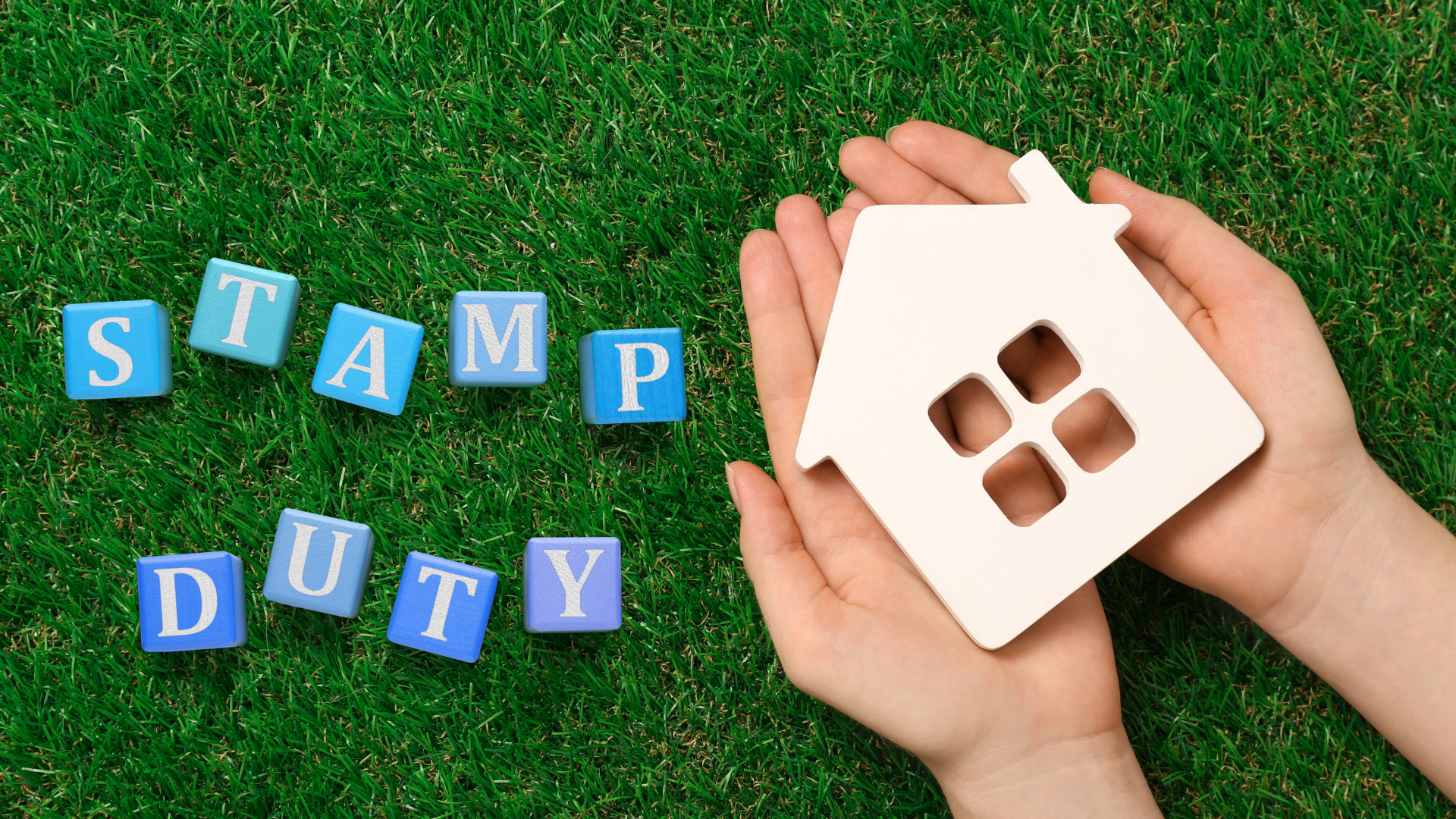- How Much Stamp Duty Land Tax Do I Need To Pay?
- What Is Stamp Duty Land Tax?
- How Does It Apply To Buy-to-Let Properties?
- Current Buy To Let Stamp Duty Land Tax in the UK
- When Must Stamp Duty Be Paid on Buy-to-Let Properties?
- Can Stamp Duty Be Added to a Buy-to-Let Mortgage?
- Stamp Duty Considerations
- What Properties Are Excluded from Buy-to-Let Stamp Duty?
- Key Takeaways
- The Bottom Line
Stamp Duty Land Tax For Buy-To-Let Properties

Buying a rental property can be a great investment. But there’s one cost that can catch you off guard: stamp duty land tax.
Unlike buying your own home, a buy-to-let usually means paying an extra 5% on top of standard stamp duty rates. This can be a significant cost, so it’s important to factor it into your budget.
With that in mind, here’s a quick guide about stamp duty land taxes for buy-to-let properties in the UK.
How Much Stamp Duty Land Tax Do I Need To Pay?
Check how much you owe using the stamp duty calculator. Simply, enter the purchase price of the property you’re buying.
What Is Stamp Duty Land Tax?
Stamp Duty Land Tax (SDLT) is a tax you pay when you buy a property or land over a certain price in England and Northern Ireland.
The tax rate depends on the price of the property, whether it’s your first home, and if you’re buying it to live in or as an investment.
How Does It Apply To Buy-to-Let Properties?
For buy-to-let properties, SDLT usually comes with a higher rate.
If you’re buying a property as an investment or a second home in England and Northern Ireland, you’ll pay an extra 5% on top of the standard rates.
This makes buy-to-let properties more expensive upfront compared to homes you’ll live in yourself.
In Wales and Scotland, the tax works a little differently.
Wales uses Land Transaction Tax (LTT), while Scotland applies Land and Buildings Transaction Tax (LBTT).
Both also add extra charges for second homes or buy-to-let properties, with Scotland including a 6% Additional Dwelling Supplement (ADS) for these purchases.
Here’s a breakdown of the current rates:
Current Buy To Let Stamp Duty Land Tax in the UK
England and Northern Ireland
| Property Price (£) | SDLT Rate (Buy-to-Let) |
|---|---|
| £0 – £40,000* | 0% |
| £40,000 – £250,000 | 5% |
| £250,001 – £925,000 | 10% |
| £925,001 – £1.5m | 15% |
| Over 1.5m | 17% |
For example, if you’re buying a £300,000 buy-to-let property in England, here’s how the SDLT works:
- First £250,000: 5% = £12,500
- Next £50,000 (up to £300,000): 10% = £5,000
- Total SDLT: £17,500
From 1 April 2025, the nil-rate band for standard residential purchases will drop back to £125,000. This will change the SDLT rates for buy-to-let properties as follows:
| Property Price (£) | SDLT Rate (Buy-to-Let) |
|---|---|
| £0 – £40,000* | 0% |
| Up to £125,000 | 5% |
| £125,001 to £250,000 | 7% |
| £250,001 to £925,000 | 10% |
| £925,001 to £1.5 million | 15% |
| Over £1.5 million | 17% |
Using the same £300,000 example, the SDLT would now be:
- First £125,000: 5% = £6,250
- Next £125,000 (up to £250,000): 7% = £8,750
- Final £50,000 (up to £300,000): 10% = £5,000
- Total SDLT: £18,500
The return of the lower nil-rate band for standard purchases (£125,000) means less of the property price will qualify for the 0% SDLT rate.
As a result, you’ll pay more tax on properties purchased after April 2025.
Since most properties in the UK are priced above £125,000, this change will likely increase the tax burden for many investors.
If you’re planning to invest in a buy-to-let property, timing matters. Buying before the changes take effect could save you thousands in SDLT
But, it’s always wise to weigh the long-term costs and benefits, including property maintenance, mortgage payments, and other tax considerations, before making your decision.
Wales: Land Transaction Tax (LTT)
| Property Price (£) | LTT Rate (Buy-to-Let) |
|---|---|
| Up to £180,000 | 4% |
| £180,001 – £250,000 | 7.5% |
| £250,001 – £400,000 | 9% |
| £400,001 – £750,000 | 11.5% |
| £750,000 – £1.5 million | 14% |
| Over £1.5 million | 16% |
Scotland: Land and Buildings Transaction Tax (LBTT)
| Property Price (£) | LBTT Standard Rate |
|---|---|
| Up to 145,000 | 0% |
| 145,001 to 250,000 | 2% |
| 250,001 to 325,000 | 5% |
| 325,001 to 750,000 | 10% |
| Over 750,000 | 12% |
ADS in Scotland is 6% and applies to the entire purchase price of properties over £40,000 when buying an additional dwelling.
When Must Stamp Duty Be Paid on Buy-to-Let Properties?
Once you’ve sealed the deal on a buy-to-let property, you have 14 days to sort out the stamp duty. This tight timeline means you need to act quickly.
Usually, the solicitor who helped with your property purchase will manage this for you. They’ll make sure the payment goes through on time and add the cost to your final bill.
This setup makes the process smoother for you, ensuring you meet the deadline without any stress.
Can Stamp Duty Be Added to a Buy-to-Let Mortgage?
The short answer is: it’s not straightforward. Most lenders set their loan-to-value (LTV) ratios to a maximum of 75-80%.
This means your mortgage can only cover this percentage of the property’s value, leaving you to fund the rest, including stamp duty, from your savings.
Adding stamp duty to your mortgage would increase your LTV ratio, and very few lenders might consider such an arrangement. It’s a risky move that could stretch your finances thin.
So, while technically possible in some rare cases, it’s usually not a practical option for most investors.
Stamp Duty Considerations
First Time Buyers
Typically, first-time buyers benefit from stamp duty relief if purchasing residential properties up to a certain value. But, this relief does not extend to buy-to-let properties unless the first-time buyer intends to live in the property.
If a first-time buyer purchases a property to let it, they will be subject to the standard rates and additional 5% stamp duty surcharge applicable to second homes and buy-to-let properties.
Married Couples and Civil Partners
For stamp duty purposes, married couples and civil partners are treated as a single entity.
If one partner owns a property, then any additional property purchased by either partner will attract higher stamp duty rates, including buy-to-let properties.
Unmarried Couples and Joint-Buyers
Unmarried couples and individuals purchasing a property jointly are assessed individually for stamp duty.
If one of the buyers doesn’t own any other property, they wouldn’t be liable for the extra 3% surcharge on their share.
But, the practical implementation of this can be complex and might vary depending on the specific circumstances.
Moving House
If you are moving house and replacing your main residence, the higher stamp duty rates for additional properties won’t apply, provided you sell your previous main residence.
If you end up owning two properties temporarily because of the moving process, you might have to pay the higher rates but could be eligible for a refund if you sell your previous main residence within 36 months.
Holding Financial Interest in a Property
Owning part of another property, like through inheritance or trust, doesn’t always mean higher stamp duty.
If your share is 50% or less, or if your interest is part of a trust or partnership, you might not face extra charges. Always tell your solicitor about any such interests.
What Properties Are Excluded from Buy-to-Let Stamp Duty?
While there aren’t any exemptions solely for buy-to-let properties, you might still benefit from general stamp duty reliefs under specific circumstances:
- Properties under a Certain Value – If you buy a property for less than £40,000 in England and Northern Ireland, you won’t need to pay stamp duty. This threshold applies to each buyer in the transaction.
- Mobile Homes, Caravans, and Houseboats – These aren’t considered ‘land’ for stamp duty purposes, so they’re not subject to these taxes.
- First-Time Buyer Relief – If you’re stepping onto the property ladder for the first time, you might qualify for a discount, even though this is less common for buy-to-let purchases.
- Multiple Dwelling Relief – Buying more than one property at once? This relief could reduce the overall stamp duty you pay.
- Charity Relief – If a charity buys a property, it might not have to pay stamp duty.
- Crown Servant Relief – If you or your spouse/civil partner are serving overseas as Crown servants, you might be exempt from the higher rates for non-UK residents.
Stamp duty rules can be complex and subject to change. Always check the latest guidelines or talk to a professional to understand how these rules apply to you.
Remember, Scotland’s LBTT and Wales’ LTT have their own sets of rules and exemptions.
Key Takeaways
- If you’re buying a buy-to-let property in England or Northern Ireland, you’ll pay an extra 5% stamp duty on top of the standard rates. From April 2025, properties between £125,001 and £250,000 will be taxed at 7%, making it more expensive to invest.
- Scotland and Wales have their own rules. In Scotland, there’s a 6% surcharge (called the Additional Dwelling Supplement) on the full property price. In Wales, buy-to-let rates start at 4% for properties up to £180,000 and go up to 16% for those over £1.5 million.
- Properties under £40,000 in England and Northern Ireland are stamp duty-free, but once the price goes over £40,000, the extra charges kick in.
- You need to pay the stamp duty within 14 days of buying the property, but your solicitor will usually sort this out for you.
- First-time buyers don’t get discounts on buy-to-let stamp duty. If it’s not your main home, the extra charges still apply. Mobile homes, caravans, and houseboats don’t have stamp duty, and there are potential tax breaks if you’re buying more than one property.
The Bottom Line
Getting professional advice can take a lot of the stress and uncertainty out of buying a buy-to-let property, especially when it comes to complex issues like stamp duty.
A buy-to-let broker can offer tailored advice based on your unique situation. Many brokers offer initial consultations for free, so you can get an idea of how they can help before you commit.
To find a specialist, get in touch with us. We’ll connect you with a reputable mortgage broker specialising in buy-to-let mortgages.
Get Matched With Your Dream Mortgage Advisor...

Frequently asked questions
Do limited companies pay stamp duty on buy-to-let purchases?
Yes, and there are no exemptions for limited companies. If transferring property to a company you own, it’s treated like a sale, requiring stamp duty payment.
How does buying a property abroad affect stamp duty?
Owning a home abroad could mean paying the surcharge for a second home in the UK. Since April 2021, overseas buyers in England and Northern Ireland face a 2% surcharge.
What defines a 'main residence' for stamp duty purposes?
Your main residence is where you predominantly live. HMRC considers various factors to determine this, such as your work location, children’s school, and voting registration.
Does inheritance affect buy-to-let stamp duty obligations?
Inheriting doesn’t incur stamp duty, but owning an inherited property may affect the rates for future purchases. Inheriting less than 50% share and buying another home after 36 months may not count as an additional property.
I'm helping my child buy a property; will I pay the 3% additional charge?
If you’re gifting money or acting as a guarantor without being on the deeds, you won’t face extra charges. Opting for a joint borrower, sole proprietor mortgage allows you to help without incurring the surcharge.
What about buying a home with an annexe?
If the annexe is within the main home’s grounds and under a third of the total value, bought together, the surcharge doesn’t apply.
What if I'm separating from my partner but still on the deeds of the old home?
You’ll pay the surcharge initially but can claim it back if you sell your share within 36 months of the new purchase.
Remember, stamp duty can be complex, and rules may change. It’s wise to consult the latest guidelines or a professional advisor for personal advice.




